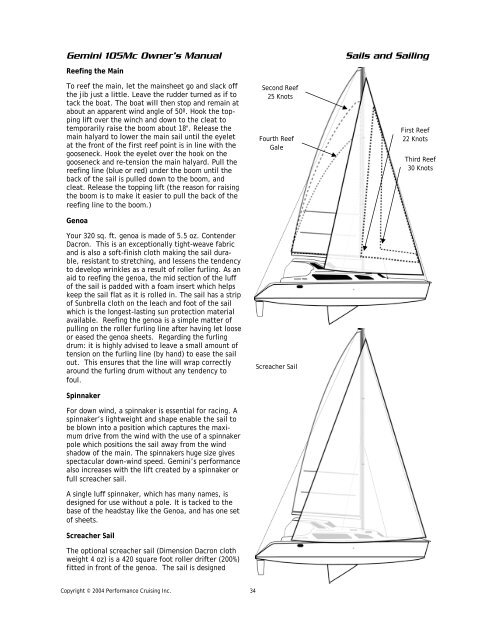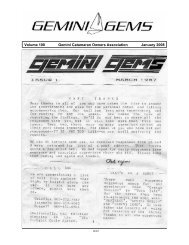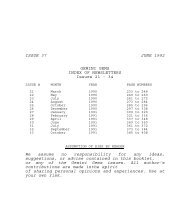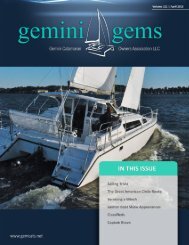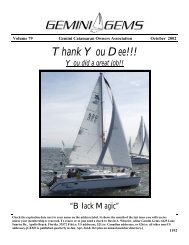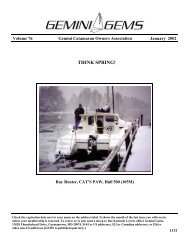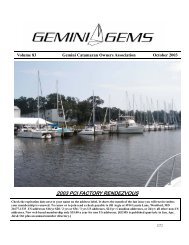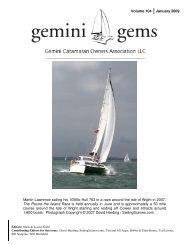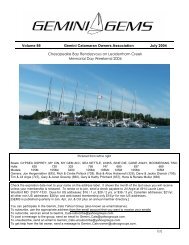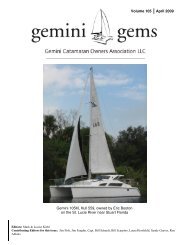Gemini Owners Manual.pub - Gemini Gems
Gemini Owners Manual.pub - Gemini Gems
Gemini Owners Manual.pub - Gemini Gems
You also want an ePaper? Increase the reach of your titles
YUMPU automatically turns print PDFs into web optimized ePapers that Google loves.
<strong>Gemini</strong> 105Mc Owner’s <strong>Manual</strong><br />
Reefing the Main<br />
To reef the main, let the mainsheet go and slack off<br />
the jib just a little. Leave the rudder turned as if to<br />
tack the boat. The boat will then stop and remain at<br />
about an apparent wind angle of 50º. Hook the topping<br />
lift over the winch and down to the cleat to<br />
temporarily raise the boom about 18". Release the<br />
main halyard to lower the main sail until the eyelet<br />
at the front of the first reef point is in line with the<br />
gooseneck. Hook the eyelet over the hook on the<br />
gooseneck and re-tension the main halyard. Pull the<br />
reefing line (blue or red) under the boom until the<br />
back of the sail is pulled down to the boom, and<br />
cleat. Release the topping lift (the reason for raising<br />
the boom is to make it easier to pull the back of the<br />
reefing line to the boom.)<br />
Genoa<br />
Your 320 sq. ft. genoa is made of 5.5 oz. Contender<br />
Dacron. This is an exceptionally tight-weave fabric<br />
and is also a soft-finish cloth making the sail durable,<br />
resistant to stretching, and lessens the tendency<br />
to develop wrinkles as a result of roller furling. As an<br />
aid to reefing the genoa, the mid section of the luff<br />
of the sail is padded with a foam insert which helps<br />
keep the sail flat as it is rolled in. The sail has a strip<br />
of Sunbrella cloth on the leach and foot of the sail<br />
which is the longest-lasting sun protection material<br />
available. Reefing the genoa is a simple matter of<br />
pulling on the roller furling line after having let loose<br />
or eased the genoa sheets. Regarding the furling<br />
drum: it is highly advised to leave a small amount of<br />
tension on the furling line (by hand) to ease the sail<br />
out. This ensures that the line will wrap correctly<br />
around the furling drum without any tendency to<br />
foul.<br />
Spinnaker<br />
For down wind, a spinnaker is essential for racing. A<br />
spinnaker’s lightweight and shape enable the sail to<br />
be blown into a position which captures the maximum<br />
drive from the wind with the use of a spinnaker<br />
pole which positions the sail away from the wind<br />
shadow of the main. The spinnakers huge size gives<br />
spectacular down-wind speed. <strong>Gemini</strong>’s performance<br />
also increases with the lift created by a spinnaker or<br />
full screacher sail.<br />
A single luff spinnaker, which has many names, is<br />
designed for use without a pole. It is tacked to the<br />
base of the headstay like the Genoa, and has one set<br />
of sheets.<br />
Screacher Sail<br />
The optional screacher sail (Dimension Dacron cloth<br />
weight 4 oz) is a 420 square foot roller drifter (200%)<br />
fitted in front of the genoa. The sail is designed<br />
Second Reef<br />
25 Knots<br />
Fourth Reef<br />
Gale<br />
Screacher Sail<br />
Sails and Sailing<br />
First Reef<br />
22 Knots<br />
Third Reef<br />
30 Knots<br />
Copyright © 2004 Performance Cruising Inc.<br />
34


